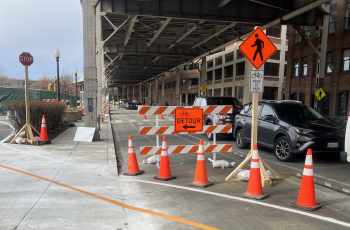The Potomac Interceptor (PI) sanitary sewer system carries about 60 million gallons of wastewater daily from areas near Dulles Airport to the Potomac Pumping Station in Washington, DC. Flows from the pump station are then sent to the Blue Plains Advanced Wastewater Treatment Plant for treatment before discharge into the Potomac River.
The PI was built as a result of the enactment of Public Law 86-515 (the Act), by the 86th Congress, on June 12, 1960. The Act authorized the District of Columbia to plan, construct, operate, and maintain a sanitary sewer to connect Dulles to the Washington, DC sewer system.
Segments
The PI system consists of four primary interceptor segments including the PI main trunk, the Upper Potomac Interceptor (UPI), the Upper Potomac Interceptor Relief Sewer (UPIRS), and the Maryland Upper Potomac Interceptor (MUPI).
- The PI main trunk is located in Maryland and Virginia and includes the Sugarland Run Extension, the Difficult Run Extension, and the Upper Maryland Spur.
- The MUPI is located in Montgomery County, Maryland and conveys flows into the UPI at the DC line.
- The UPI starts at the Maryland/DC border and currently conveys flows from the MUPI and other service connections in the District to the UPIRS.
- The UPIRS begins at the D.C. border and conveys flow from the PI main trunk and other service connections to Blue Plains.
The District of Columbia Water and Sewer Authority operates and maintains the PI system with the exception of the MUPI, which is operated and maintained by the Washington Suburban Sanitary Commission.
The PI varies in size from 30-inch to 96-inch diameter round, reinforced concrete pipe in the main trunk to 13-foot by 7.75-foot rectangular, reinforced concrete pipe in the lower reaches of the sewer system. The original sewer design included provisions for interceptor venting at the manholes and access shafts along most of the sewer system to promote the exhaust of sewer gases or the intake of air as needed.
However, between 2012 and 2015 DC Water constructed six odor control facilities along the PI to mitigate the release of sewer gases and odors to surrounding parks and public spaces, minimizing off-site impacts and the potential for odor complaints pertaining to the Potomac Interceptor.
Jurisdictions served by the Potomac Interceptor
- Town of Vienna
- Loudoun County (VA)
- Fairfax County (VA)
- Washington Dulles International Airport
- Washington Suburban Sanitary Commission (WSSC)
- National Park Services
- Navy Yard
Inspection and Rehabilitation of the Potomac Interceptor
Between 2011 and 2015, DC Water inspected the entire Potomac Interceptor. The individual pipe segments inspected indicate the majority of the pipe segments show signs of corrosion, and some show settled deposits. DC Water plans to rehabilitate corroded pipe segments, and to clean pipe segments that have significant settled deposits. DC Water is taking corrosion prevention measures to reduce the rate of pipe corrosion.
Information about specific rehabilitation efforts is available under the Projects section of this website, including:
Potomac Interceptor Sewer Rehabilitation Project
Potomac Interceptor LZ07 Project
Contacts
DC Water Potomac Interceptor Projects Portfolio Manager, Eyasu Yilma, PE
202-787-7061 Email: Eyasu.Yilma@dcwater.com
Odor Issues, Spills and Concerns - 24/7 Emergency Command Center
202-612-3400


